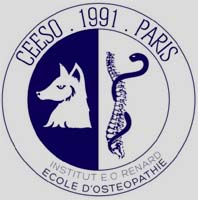Effets d’une technique ostéopathique myotensive de l’articulation temporo-mandibulaire sur la vitesse maximale aérobie (VMA) de footballeurs amateurs
LOUBERE-CLAVERIE Gwenaële

Mémoire en vue de l’obtention d’un diplôme d’ostéopathe - Centre Européen d’Enseignement Supérieur en Ostéopathie — CEESO 2016 - Tuteur : Maud LESECH, Ostéopathe D.O - Second tuteur : Nicolas ALLONCLE, ostéopathe D.O - Présenté le 28 Avril 2016
Le Site de l’Ostéopathie remercie le Directeur du CEESO Paris de l’avoir autorisé à présenter ce mémoire
Résumé
Introduction : La performance sportive est au centre des préoccupations sportives, particulièrement au sein du football. La VMA est un indicateur fiable et accessible de la performance sportive. De nombreuses études permettent de faire le lien entre l’articulation temporo-mandibulaire (ATM) et son impact sur la posture, qui doit être la plus efficiente possible afin de limiter les dépenses énergétiques à la seule action sportive.
Objectifs : démontrer la possible efficacité d’une technique ostéopathique myotensive sur l’articulation temporo-mandibulaire et son implication éventuelle sur une augmentation de la VMA, facteur d’amélioration de la performance sportive.
Méthodes : 10 footballeurs amateurs ont été répartis de manière aléatoires en deux groupes : l’un traité par une technique myotensive sur le muscle masséter, l’autre traité par une technique light touch, gold standard du traitement placebo en ostéopathie, dans la zone temporo-mandibulaire. Chaque groupe ayant dû réaliser deux tests du Demi-Cooper, avant et après application des techniques, afin d’évaluer l’évolution de leur VMA.
Résultats : l’étude n’a pas démontré l’existence de résultats significatifs d’un point de vue statistique tant au niveau du traitement ostéopathique (p =0,0625) qu’au niveau du traitement light touch (p =). Néanmoins le groupe traité en technique myotensive démontre une augmentation de la VMA bien plus importante que dans le groupe traité en light touch.
Conclusion : L’efficacité d’une technique myotensive sur l’ATM n’a pas pu être mise en lien avec l’amélioration de la VMA. Néanmoins, l’existence de biais modifiables, particulièrement le nombre de sujets, et un état des lieux des études actuelles sur le sujet laissent à penser que d’autres études seraient nécessaires afin d’objectiver le lien possible entre traitement de l’ATM en ostéopathie et amélioration de la performance.
Mots clefs : articulation temporo-mandibulaire, vitesse maximale aérobie (VMA), performance, techniques myotensives (MET)
Abstract
Title : Effects of a myotensive osteopathic technique of the temporo-mandibular joint on the maximum aerobic speed (MAS) regarding amateur footballers.
Introduction : The athletic performance is one of today’s sportive concerns, especially within the football field. The MAS is reliable and accessible indicator of the sportive performance. Several studies allow to establish the link between the temporo-mandibular joint (TMJ) and its effect on the posture, which have to be as efficient as possible in order to limit energy expenditures during the sportive activity.
Objectives : demonstrate the possible efficiency of a myotensive osteopathic technique on the temporomandibular joint and its possible involvement on the rise of the MAS, improvement factor of the sportive performance.
Methodology : 10 amateur footballers have been randomly separated into two groups : one treated by a myotensive technique on the masseter muscle, the other one treated by a light touch technique, gold standard of the placebo treatment in osteopathy, within the temporo-mandibular area. Each group had to make two Demi-Cooper tests, before and after application of the techniques, in order to evaluate the evolution of their MAS.
Results : the study has not demonstrated the existence of significant results on a statistical point of view, neither about the osteopathic treatment (p =0,0625) nor regarding the light touch treatment (p =). However, the treated group by the myotensive technique demonstrate a rise of the MAS far more important than the group treated by the light touch technique.
Conclusion : The myotensive technique effectiveness on the TMJ cannot be linked with the improvement of the MAS. However, the existence of modifiable biases, especially the number of applicants, and a situational analysis of the current studies on this subject suggests that other studies would be needed to further explore the link between TMJ treatment in osteopathy and performance improvement.
Key words : temporo-mandibular joint, maximum aerobic speed (MAS), performance, technical myotensives



